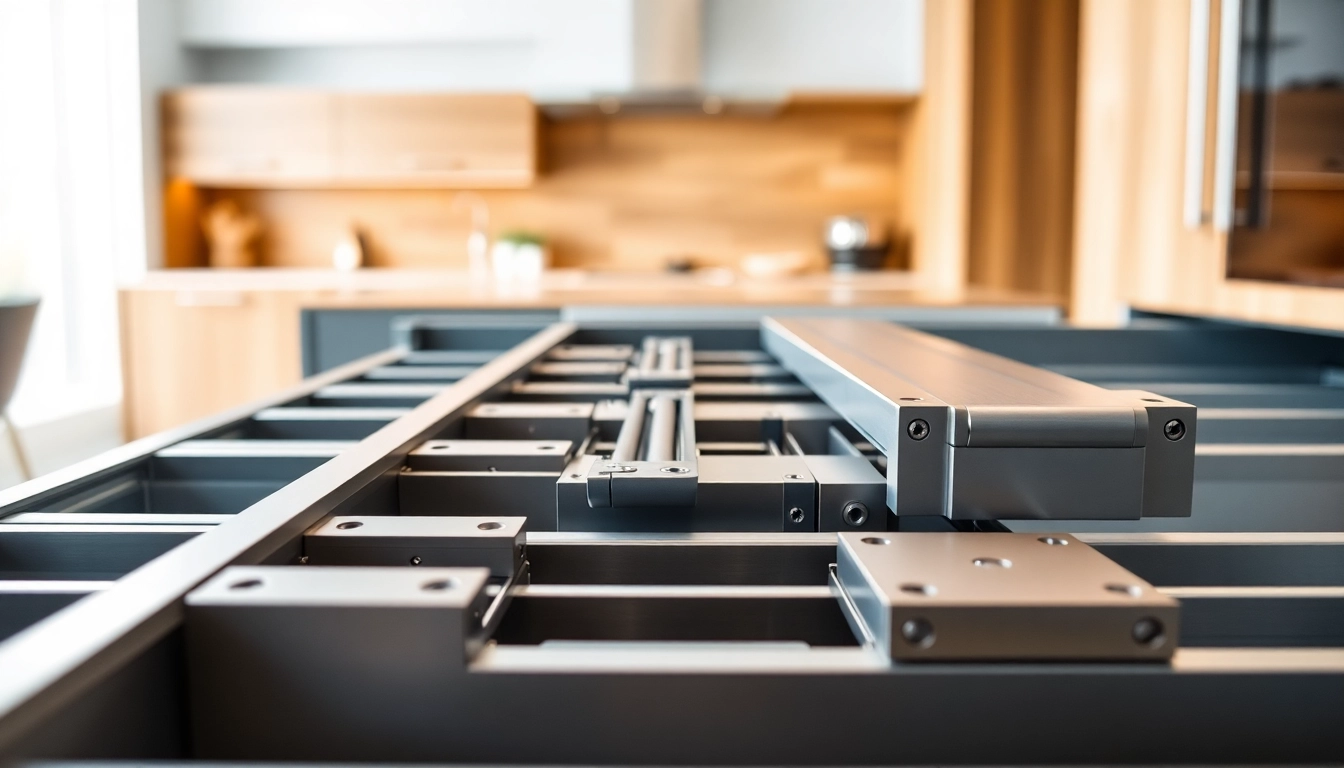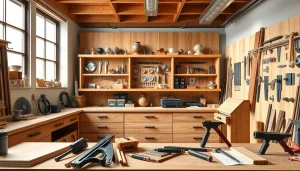1. Understanding Metal Drawer Systems
When it comes to functional furniture design and efficient storage solutions, metal drawer systems are an essential component. These systems are increasingly favored in both residential and commercial settings due to their durability, functionality, and aesthetic appeal. They offer a range of options that cater to varying storage needs, from sleek kitchen drawers to robust workshop storage.
Metal drawer systems are used in multiple applications, providing a seamless blend of utility and style in cabinetry. If you are looking to implement modern storage solutions, understanding the nuances of a Metal Drawer System is imperative.
1.1 What Defines a Metal Drawer System?
At its core, a metal drawer system consists of drawer boxes and the necessary mechanisms (slides and runners) that facilitate smooth opening and closing. Unlike traditional wooden drawers, metal systems often utilize materials such as steel or aluminum which offer superior strength and stability. They are available in various finishes and configurations, allowing them to blend seamlessly into any decor.
The design of metal drawer systems can include features such as soft-close mechanics, which prevent slamming, and full-extension slides that allow complete access to the contents of the drawer. These features enhance user experience and provide added functionality that wooden systems may lack.
1.2 Common Applications and Uses
Metal drawer systems find their place in numerous environments:
- Residential Kitchens: Often used for cutlery, pots, and other cookware due to their durability and ease of cleaning.
- Commercial Spaces: Ideal for filing cabinets and other office furniture, providing sturdy storage for documents and supplies.
- Workshops and Garages: Excellent for holding tools and parts due to their ability to bear heavy weights.
- Retail Display: Used for showcasing merchandise while keeping storage organized.
1.3 Key Benefits of Metal Drawer Systems
Investing in metal drawer systems comes with numerous advantages:
- Durability: Metal drawers withstand more wear and tear compared to wooden counterparts, making them suitable for high-traffic areas.
- Easy Maintenance: Metal surfaces are often easier to clean and less susceptible to staining than wood.
- Security: Many metal systems can be secured with locks, making them ideal for sensitive storage.
- Design Versatility: Available in a wide array of finishes, colors, and styles to match various aesthetics.
2. Types of Metal Drawer Systems
2.1 Standard Metal Drawer Slides
Standard metal drawer slides are widely used and can be categorized into side-mounted, bottom-mounted, and center-mounted varieties:
- Side-mounted slides: Installed on the sides of the drawer, they provide reliable support and are commonly available in both ball-bearing and roller options.
- Bottom-mounted slides: Located beneath the drawer, they allow for a cleaner look by hiding the mechanism while providing stability.
- Center-mounted slides: These typically feature a single slide that runs down the center of the drawer making them more discreet.
2.2 Heavy-Duty Metal Drawer Options
For more demanding applications, heavy-duty drawer systems are designed to carry greater loads. These include features such as:
- Reinforced Structures: Sturdy materials capable of withstanding immense weight without deforming.
- Telescopic Slides: Allowing drawers to extend in full, providing complete access to contents.
- Locking Mechanisms: Essential for secure storage of valuable or sensitive items.
2.3 Specialized Metal Drawer Mechanisms
Some metal drawer systems incorporate specialized mechanisms for unique applications or aesthetics:
- Soft-Close Mechanisms: Essential for preventing slamming and ensuring a smooth, gentle closure.
- Self-Close Mechanisms: Allow drawers to automatically close when pushed, adding convenience.
- Frame-less Designs: Modern aesthetic that allows for seamless integration into cabinetry.
3. Selecting the Right Metal Drawer System
3.1 Factors to Consider
Choosing the right metal drawer system requires careful consideration of several factors:
- Load Capacity: Assess the weight that the drawer will need to support to ensure the slides match the requirement.
- Drawer Size: Measurements are critical as dimensions will dictate which systems can be used.
- Installation Method: Consider whether the drawer will be installed as a side mount, bottom mount, or center mount.
- Design Style: Ensure the metal finish and design align with the overall aesthetic of the space.
3.2 Comparing Metal Drawer Systems
When comparing various metal drawer systems, consider the following:
- Durability Tests: Check for certifications that indicate the durability and performance of the drawer components.
- Customer Reviews: Look for feedback on ease of installation and reliability over time.
- Warranty Options: A longer warranty often indicates greater confidence in product longevity.
3.3 Compatible Drawer Sizes and Styles
Different metal drawer systems cater to varying drawer sizes and styles:
- Standard sizes are available to fit most kitchen and office cabinets, while custom sizes can be made to suit specific requirements.
- Styles can range from traditional designs to contemporary, minimalist forms to suit diverse décor themes.
4. Installation and Maintenance Tips
4.1 Step-by-Step Installation Guide
Installing a metal drawer system can be straightforward when following a systematic approach:
- Gather Tools: Collect necessary tools like a screwdriver, tape measure, and level.
- Measure: Take precise measurements of the drawer opening and corresponding components.
- Position the Slides: Attach the slides to the drawer and the cabinet frame, ensuring they are level.
- Insert the Drawer: Place the drawer onto the slides, checking for smooth movement.
- Test the Mechanism: Verify that the drawer opens and closes seamlessly.
4.2 Regular Maintenance Practices
Keeping metal drawer systems in optimal condition is essential for longevity. Regular maintenance tips include:
- Cleaning: Dust and wipe down the surfaces to prevent buildup of debris that could hinder performance.
- Inspecting: Regularly check for loose screws or misalignment.
- Lubrication: Apply a suitable lubricant periodically to maintain smooth operation.
4.3 Troubleshooting Common Issues
Even the most robust systems may encounter issues. Common problems include:
- Drawer Not Closing Properly: Check for obstructions in the drawer path and ensure alignment of slides.
- Squeaking or Sticking: Apply lubricant to the slides to reduce friction.
- Drawer Won’t Open: Ensure that the mechanism is intact and that no external lock is engaged.
5. Enhancing Your Space with Metal Drawer Systems
5.1 Design Inspirations and Trends
Incorporating metal drawer systems into your spaces doesn’t mean sacrificing aesthetics. Here are current design trends:
- Minimalist Designs: Clean lines and simple forms create an understated elegance.
- Contrasting Materials: Combining metal with wood can give depth and interest to furniture pieces.
- Custom Finishes: Offering painted or coated finishes to match your specific color palette enhances overall design cohesion.
5.2 Customizing Your Storage Solutions
Metal drawer systems offer versatility that can be customized according to individual needs:
- Adjustable Dividers: Enhanced organization allows users to segment spaces within drawers.
- Integrated Lighting: Adding LED lighting can bring visibility to contents, facilitating efficient use.
- Personalized Finishes: Tailoring your metal finishes can give your systems a unique flair.
5.3 Future-Proofing Your Drawer Systems
As trends evolve, future-proofing your metal drawer systems can ensure they remain functional and relevant:
- Modular Designs: Step towards modularity allows for flexibility in adapting layouts.
- Smart Technology Integration: Consider future-friendly features such as electronic locks and app integrations.
- Sustainability: Source environmentally friendly materials and practices to keep up with modern consumer preferences.








